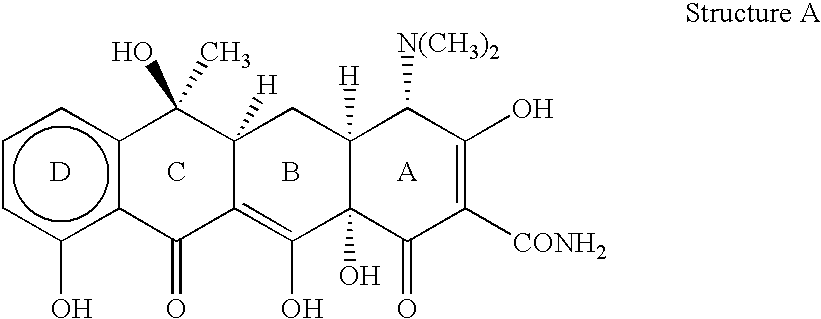Methods of treating acne
a technology of acne and acne gel, applied in the field of acne gel, can solve the problems of not being able to reduce the number of propionibacteria/mg of comedones, the number of comedones is not expected to decrease, and the scars are permanent, so as to reduce the number of comedones
- Summary
- Abstract
- Description
- Claims
- Application Information
AI Technical Summary
Benefits of technology
Problems solved by technology
Method used
Image
Examples
example 1
4-Dedimethylamino-7-dimethylamino-6-demethyl-6-deoxy-9-nitrotetracycline Sulfate
[0086] To a solution of one millimole of 4-dedimethylamino-7-dimethylamino--6-demethyl-6-deoxytetracycline in 25 ml of concentrated sulfuric acid at 0.degree. C. was added 1.05 mmole of potassium nitrate. The resulting solution was stirred at ice bath temperature for 15 minutes and poured in one liter of cold ether with stirring. The precipitated solid was allowed to settle and the majority of solvent decanted. The remaining material was filtered through a sintered glass funnel and the collected solid was washed well with cold ether. The product was dried in a vacuum desiccator overnight.
example 2
9-amino-4-dedimethylamino-7-dimethylamino-6-demethyl-6-deoxytetracycline Sulfate
[0087] To a solution of 300 mg of the 9-nitro compound from example 1, in 30 ml of ethanol was added 50 mg of PtO.sub.2. The mixture was hydrogenated at atmospheric pressure until the theoretical amount of hydrogen was absorbed. The system is flushed with nitrogen, the catalyst PtO.sub.2 is filtered and the filtrate added dropwise to 300 ml of ether. The product that separates is filtered and dried in a vacuum desiccator.
example 3
9-Acetamido-4-dedimethylamino-7-dimethylamino-6-demethyl-6-deoxytetracycli-ne Sulfate
[0088] To a well stirred cold solution of 500 mg of 9-amino-4-dedimethylamino-7-dimethylamino-6-demethyl-6-deoxytetracycline sulfate from example 2, in 2.0 ml of 1.3-dimethyl-2-imidazolidinone, 500 mg of sodium bicarbonate was added followed by 0.21 ml of acetyl chloride. The mixture is stirred at room temperature for 30 minutes, filtered and the filtrate was added dropwise to 500 ml of ether. The product that separated was filtered and dried in a vacuum desiccator.
PUM
| Property | Measurement | Unit |
|---|---|---|
| concentration | aaaaa | aaaaa |
| concentration | aaaaa | aaaaa |
| concentration | aaaaa | aaaaa |
Abstract
Description
Claims
Application Information
 Login to View More
Login to View More - R&D
- Intellectual Property
- Life Sciences
- Materials
- Tech Scout
- Unparalleled Data Quality
- Higher Quality Content
- 60% Fewer Hallucinations
Browse by: Latest US Patents, China's latest patents, Technical Efficacy Thesaurus, Application Domain, Technology Topic, Popular Technical Reports.
© 2025 PatSnap. All rights reserved.Legal|Privacy policy|Modern Slavery Act Transparency Statement|Sitemap|About US| Contact US: help@patsnap.com



